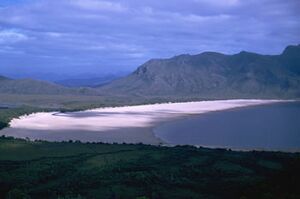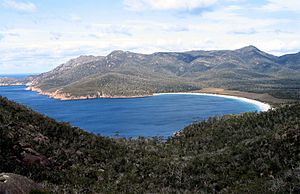Tasmania Parks and Wildlife Service facts for kids
 |
|
| Agency overview | |
|---|---|
| Formed | 1 November 1971 |
| Jurisdiction | Government of Tasmania |
| Minister responsible |
|
| Agency executive |
|
| Parent agency | Department of Primary Industries, Water and Environment (Tasmania) |
The Tasmania Parks and Wildlife Service is a special group in the Tasmanian Government. Their main job is to look after Tasmania's amazing natural places. These include national parks, important historic sites, and other protected areas. They manage these places on public land, making sure they stay safe and beautiful for everyone. They also help manage wildlife, like animals that can be hunted.
Contents
Protecting Tasmania's Wild Places
The Tasmania Parks and Wildlife Service helps protect many different types of land. They look after national parks, which are large areas of natural beauty. They also care for historic sites, which are places important for Tasmania's past. Their work helps keep Tasmania's unique plants and animals safe.
How the Service Started
The National Parks and Wildlife Service began on 1 November 1971. This happened after a big argument about flooding Lake Pedder. Many people wanted to stop the flooding, but they couldn't. This event made people realize Tasmania needed a better way to protect its nature. So, a special committee suggested creating a professional group to manage the environment.
The new service started with 59 staff members. A law called the National Parks and Wildlife Act 1970 helped them. This law made it possible to protect animals and plants. It also helped set up and manage national parks. Some of the first parks created were Mount William, Maria Island, and Narawntapu. Macquarie Island was also made a nature reserve.
Growing and Changing
A few years later, a new section was added to the service. This was the Archaeology Section, which looked after old Aboriginal sites. This happened because of a new law called the Aboriginal Relics Act 1975.
In 1976, Precipitous Bluff became part of the Southwest National Park. In 1979, there was another big debate. This time, it was about building a power station that would flood the Franklin River. This led to the creation of the Franklin-Lower Gordon Wild Rivers National Park in 1981. The dam was eventually stopped by a court decision in 1983.
Over the years, the service joined with other government departments. In 1987, it joined with the Department of Lands. This created a bigger group that looked after land, parks, and wildlife.
In 1989, the department changed again. It became responsible for managing public land, nature reserves, wildlife, and historic places. The Royal Tasmanian Botanical Gardens and the Port Arthur Historic Site Management Authority also became part of this larger department.
Protecting More Land and Sea
In 1989, the Douglas-Apsley National Park was created. This park is important for its dry forests. The Tasmanian Wilderness World Heritage Area also grew much larger. It became about 20% of Tasmania's size. This area is recognized worldwide for its special natural beauty.
In 1990, Tasmania created its first marine reserves. These were special protected areas in the ocean near Maria Island, Governor Island, Tinderbox, and Ninepins Point.
In 1993, the department merged again. The Parks and Wildlife Service became a separate part of a new department. This year, they also started charging fees to visit parks. These fees helped pay for new visitor centers and walking trails.
Some land that the service managed was given back to the Aboriginal Land Council of Tasmania. A special group was also created to train Aboriginal people. This helped them advise on how to manage Aboriginal heritage sites.
In the mid-1990s, more national parks were created. These included the Mole Creek Karst National Park in 1996 and South Bruny National Park in 1997.
Under a plan called the Regional Forestry Agreement (RFA), even more public land was added to Tasmania's reserves. This increased the protected public land by 17%. This agreement also made parks like Mount William National Park and Freycinet National Park bigger. It also created new parks like Tasman and Savage River.
After 1998, the Parks and Wildlife Service became part of an even larger department. This new department was called the Department of Primary Industries, Water and Environment (DPIWE).
The Parks and Wildlife Service later split into two parts. One part looked after natural and cultural resources. The other part focused on Tasmania's parks, reserves, and World Heritage Areas. In 2002, the Parks and Wildlife Service became part of a new department focused on tourism, parks, heritage, and the arts.
In 2002, three islands – Deal, Erith, and Dover – became part of the Kent Group National Park. New marine protected areas were also created near Port Davey-Bathurst Harbour.
In 2006, the department changed its name again to the Department of Tourism, Arts and the Environment.
In 2007, the Tasmanian Coast Conservation Fund was set up. This fund helps the Parks and Wildlife Service protect Tasmania's environment. It gets money from tour companies and environmental groups. This shows how different groups work together to keep Tasmania's beautiful places safe.



